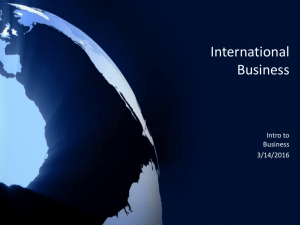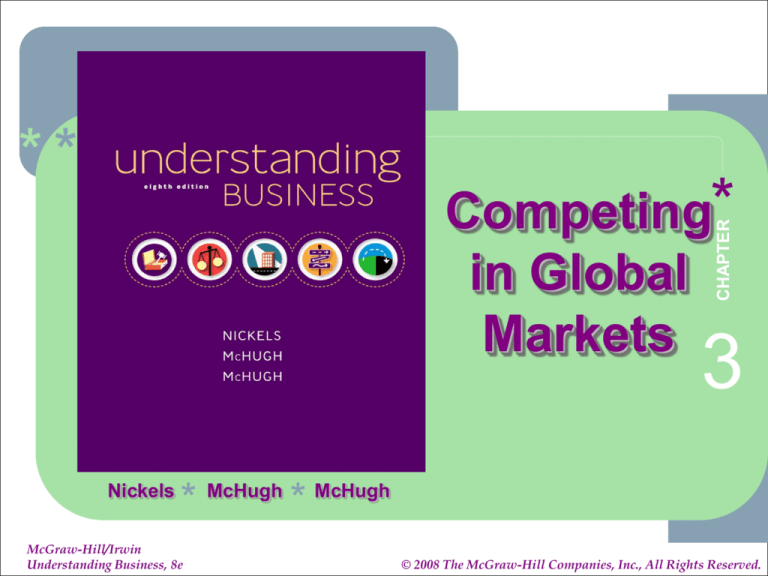
*
*
*
**
CHAPTER
Competing*
in Global
Markets
3
Nickels
*
McGraw-Hill/Irwin
Understanding Business, 8e
McHugh
*
McHugh
1-1
3-1
© 2008 The McGraw-Hill Companies, Inc., All Rights Reserved.
*
*
*
The Dynamic Global Market
World Population by continent:
1% 8%
6%
United States
South America
12%
Africa
Europe
Asia
60%
13%
Australia
** The U.S. is the largest importing nation in the World!
3-2
*
*
*
Growing World Population
12
10.8
10
In Billions
8
6
8.5
5.3
6.0
6.5
1998
2010
4
2
0
1990
2030
2060
Source: Population Reference Bureau
3-3
*
*
*
Why Trade ??
Reasons FOR trading with other nations include:
No nation can produce all the products that its people need.
Nations seek trade with countries to meet the needs of their people.
MUTUALLY BENEFICIAL EXCHANGE
Some nations have abundant natural resources and lack technological
know-how.
Others have sophisticated technology but few natural resources.
Global trade relations enable countries to produce what they can and
buy the rest in a MUTUALLY BENEFICIAL EXCHANGE.
3-4
*
*
*
Why Trade With
Other Nations?
• No nation can produce all
its needs
• Mutually beneficial
exchange
• Natural Resources or
Technology- Produce or
Buy?
3-5
*
*
*
Theories of Advantage
Comparative
U. S.
China
China
U. S.
Output per
Unit of Input
Software
Clothing
3-6
*
*
*
Theories of Advantage
Absolute = Virtual Monopoly
South Africa
Output per
Unit of Input
The Rest of
the World
Diamond Production
3-7
*
*
*
Global Competitiveness
Country
Strengths
United States
Technology,
R & D Spending
Finland
Univ. Enrollment, Efficient Legal
System, Business Ethics
Taiwan
Cell-phone Ownership,
Tech. Innovation,
Local Firms Competitiveness
Singapore
Savings Rate, Math/Science
Education, Political Trust
Sweden
H.S. Enrollment, Press Freedom,
Phone Access
3-8
*
*
*
Global Trade
• Goods & Services
• Importing
• Exporting
• Measuring Trade
• Balance of Trade/Payments
• Trade Deficit
• Dumping
3-9
*
*
*
Importing versus export
The U.S. is the LARGEST EXPORTING NATION in
the world. It is the world’s largest importer as
well.
IMPORTING
is buying products from another country.
EXPORTING
is selling products to another country.
3-10
*
*
*
How are imports paid for ?
We must pay for foreign goods with foreign
currency .
That is that we have to convert dollars to the
foreign currency of the seller .
This creates an exchange rate
3-11
*
*
*
Balance of Trade
Balance of Payments
BALANCE OF TRADE
is a nation’s ratio of exports to imports.
A favorable balance (trade surplus) of trade exists when the value
of a nation’s exports exceeds its imports.
A trade deficit is when imports exceed exports
BALANCE OF PAYMENTS
is the difference between money coming into a country (from
exports) and money leaving the country (for imports) plus
money flows from other factors such as tourism, foreign aid,
military expenditures, and foreign investment.
Balance of payments deficit or balance of payments surplus
3-12
*
*
*
U. S. Trade in
Goods & Services (Billions)
1600
1400
Balance of
Trade
1200
1000
800
600
400
Exports
200
Imports
0
1975 1980 1985 1990
1995 2000 2002 2005
Source: St. Louis Business Monthly, Oct. 1999 & World Trade Organization & Wikipedia
3-13
*
*
*
Leading Goods
Exporters/Importers
In Billions $
Country
United States
Germany
Japan
France
United Kingdom
World Total
Source: Wikipedia, 2005
Exports
928
1016
539
443
374
9,099
Imports
1,476
717
402
420
439
8,823
3-14
*
*
*
Country Presence
of Well-Known Companies
Krispy Kreme
7-Eleven
Starbucks
McDonald's
Whirlpool
UPS
FedEx
0
50
100
150
200
250
Source: World Features Syndicate
3-15
*
*
*
Starbucks’ Expansion
World Locations
29%
71%
International
U.S.
Source: Starbucks.com May 2006
3-16
*
*
*
Forces Affecting Trading
in Global Markets
• Socio-cultural
• Economic & Financial
• Legal & Regulatory
• Physical & Environmental
3-17
*
*
*
Cultural Differences
in Global Markets
• Language
• Religion
• Social
Structure
• Aesthetics
• Values &
Attitudes
• Personal
Communication
3-18
*
*
*
Economic & Financial Forces
• No Worldwide Currency
• Currency Fluctuations
• Floating Exchange Rates
• Bartering/Countertrading
3-19
*
*
*
Most Spoken Languages
4%3%1%
English
11%
Spanish
Other IndoEuropean
Asian and
Pacific Island
Other
Most Spoken
Languages
in the U.S.
81%
22%
Most Spoken
Languages
in the World
Mandarin
Chinese
Spanish
English
7%
Hindi
8%
Portuguese
13%
Source: 2005 CIA World Factbook
37%
13%
Other
3-20
*
*
*
Strategies for
Reaching Global Markets
• Licensing
• Joint Ventures &
Strategic Alliances
• Exporting
• Franchising
• Foreign Direct
Investment
• Contract
Manufacturing
• Joint Ventures
3-21
*
*
*
Strategies for
Reaching Global Markets
LICENSING
is a global strategy in which a firm (the licensor) allows a foreign
company (the licensee) to produce its products in exchange for
a fee (a royalty.)
• How do world population and market statistics support the
expansion of U.S. businesses into global markets?
• What is comparative advantage, and what are some examples of
this concept in actual global markets?
• How are a nation’s balance of trade and balance of payments
determined?
3-22
*
*
*
Strategies for
Reaching Global Markets
The ADVANTAGES of licensing are:
A company can gain ADDITIONAL REVENUES from a product it would
not have normally produced domestically.
A company can gain from the sale of start-up supplies, component
materials, and consulting services from the licensing firm.
The LICENSOR SPENDS LITTLE OR NO MONEY to produce and
market the product; costs come from the licensee’s pocket.
3-23
*
*
*
Strategies for
Reaching Global Markets
The PROBLEMS of licensing are:
Often a firm must GRANT LICENSING RIGHTS to its product for an
extended period.
If a product experiences remarkable growth in the foreign market,
the BULK OF THE REVENUES GO TO THE LICENSEE.
If the foreign licensor learns the technology, it may
BREAK THE AGREEMENT and begin to produce
A SIMILAR PRODUCT ON ITS OWN.
3-24
*
*
*
Strategies for
Reaching Global Markets
FOREIGN DIRECT INVESTMENT
is buying permanent property and business in foreign nations.
A FOREIGN SUBSIDIARY is a company owned in a foreign country
by another company (parent company).
THE LEGAL REQUIREMENTS of both the parent (home) and the
foreign (host) countries must be observed.
The ADVANTAGE of foreign subsidiaries is that the COMPANY
MAINTAINS COMPLETE CONTROL over any technology or
expertise it may possess.
The major SHORTCOMING is that the firm’s ASSETS COULD BE
TAKEN OVER BY THE FOREIGN GOVERNMENT, called
EXPROPRIATION, if relations with the host country fail.
3-25
*
*
*
Strategies for
Reaching Global Markets
FRANCHISING
is an arrangement whereby someone with a good idea for
a business sells the rights to use the business name.
Franchising is popular both domestically and in global
markets.
FRANCHISERS MUST ADAPT IN THE
COUNTRIES THEY SERVE.
Domino’s Pizza found that Japanese
enjoyed squid and sweet mayonnaise pizza.
3-26
*
*
*
Strategies for
Reaching Global Markets
CONTRACT MANUFACTURING
involves a foreign country’s production of private-label
goods to which a domestic company then attaches its
brand name or trademark; also called outsourcing
(text example: Nike.)
Using contract manufacturing a company can often
experiment in a new market
WITHOUT HEAVY START-UP COSTS.
A firm can also use contract manufacturing temporarily
to MEET AN UNEXPECTED INCREASE IN ORDERS.
Also, labor costs are low.
3-27
*
*
*
Strategies for
Reaching Global Markets
INTERNATIONAL JOINT VENTURES AND
STRATEGIC ALLIANCES
A JOINT VENTURE is a partnership in which two or
more companies (often from different countries) join
to undertake a major project.
The text offers the example of the joint venture among
Volkswagen, General Motors, and China’s Shanghai
Automotive Industrial Corporation.
3-28
*
*
*
Foreign Direct
Investments in the U.S.
1200000
1000000
800000
600000
400000
200000
0
Europe
Latin
America
Asia
Canada
Source: Bureau of Economic Analysis, 2004
3-29
*
*
*
World’s Largest MNCs
A MULTINATIONAL CORPORATION
is an organization that manufactures and markets products in
many different countries and has
multinational stock ownership and multinational management.
Only firms that have manufacturing capacity or other physical
presence in different nations can truly be called multinational.
Different strategies reflect different levels of ownership, financial
commitment, and risk.
Source: Business Week; Morgan Stanley Capital International; and S&P Compustat
3-30
*
*
*
World’s Largest MNCs
1) Wal-Mart Stores
2) Exxon Mobil
3) General Motors
4) BP
5) Ford Motor
6) Daimler Chrysler
7) Royal Dutch/Shell
8) General Electric
9) Toyota Motor
10) Mitsubishi
Revenue ($Billions)
217
213
175
174
162
136
135
125
121
112
Source: Business Week; Morgan Stanley Capital International; and S&P Compustat
3-31
*
*
*
What’s On Your Pizza
•
•
•
•
•
•
•
Costa Rica - Coconut
France - Bacon, onion and fresh cream
India - Pickled ginger, minced mutton and tofu
Australia - Shrimp and pineapple
Pakistan - Curry
Brazil - Green peas
Japan - Squid and mayo jaga
Source: World Features Syndicate
3-32
*
*
*
Did You Know?
• In Turkey it’s rude to cross your arms
while you are facing someone.
• In the Arab world the left hand is
considered unclean; don’t eat with it!
• In India never pat someone’s head,
it’s the seat of the soul.
• The Chinese associate gifts such as
straw sandals, clocks and
handkerchiefs with funerals.
3-33
*
*
*
U.S. Oil Imports
Canada
18%
Mexico
33%
Venezuela
15%
12%
12%
10%
Nigeria
Saudi Arabia
Other
Source: Gibson Consulting 2005
3-34
*
*
*
Legal & Regulatory Forces
1. Inconsistent Laws &
Regulations
2. Foreign Corrupt
Practices Act of 1978
3. Local Business Contact
Required
3-35
*
*
*
Developing Countries
Need Infrastructure
• 1.2 billion people lack clean
drinking water
• 2 billion people
lack electricity
• 3 billion people lack
adequate sanitation
3-36
*
*
*
Protectionism
• Mercantilism
• Tariffs
• Protective
• Revenue
• Import Quota
• Embargo
• Nontariff Barriers-Keiretsu
3-37
*
*
*
Tariffs
Revenue Tariff
versus
Protective Tariff
Revenue tariff is imposed as a tax to raise money
Protective tariff is imposed to “protect” domestic
production by raising the cost of imported
production fro other countries
3-38
*
*
*
Tariffs
Import Quotas
An import quota restricts the quantity of imports
Basic economics (supply and demand)
says limit supply prices go up which will cause to
substitution to domestically produced goods
3-39
*
*
*
Tariffs
Embargos
Complete restriction of imports
Usually only imposed for political and not
economic reasons
3-40
*
*
*
Trade Agreements
•
•
•
•
General Agreement on Tariffs & Trade (1948)
Uruguay Round of GATT (1986)
World Trade Organization (1995)
Common Markets
• European Union (EU)
• Mercosur
• North American Free Trade Agreement (1994)
• Central America Free Trade Agreement
(2005)
3-41
*
*
*
Future Global Trade
• People’s Republic of ChinaPermanent Normal Trade
Relations/Rights
• Russia & Others
• Internet
•Technology- Obstacles/Problems
3-42
*
*
*
Pro’s & Con’s of
Offshore Outsourcing
Pro’s
Con’s
• More focus on areas
where they can excel and
grow
• Jobs lost/wages fall
• Outsourced work creates
efficiencies, resulting in
hiring more workers
• Communication
becomes much more
difficult
• Reduces product quality
• Fuels global market
growth
3-43
*
*
*
Why Trade ??
FREE TRADE
is the movement of goods and services among
nations without political or economic
obstruction.
3-44

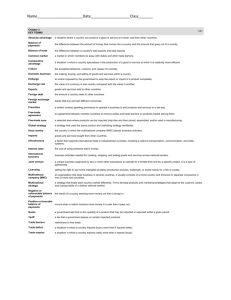
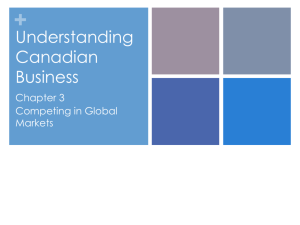
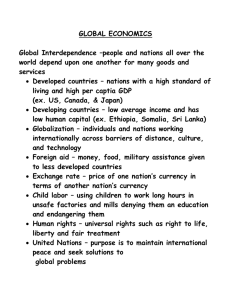
![Quiz About [Your Topic]](http://s3.studylib.net/store/data/009237721_1-467865351cf76015d6a722694bb95331-300x300.png)
